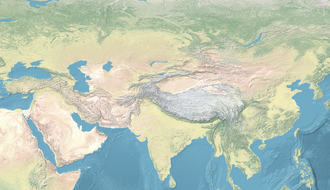| Geographical range | Mongolia |
|---|---|
| Period | Middle Bronze Age |
| Dates | 1800 BCE — 1600 BCE |
| Preceded by | Afanasievo culture Chemurchek culture |
| Followed by | Sagsai culture Deer stones culture |

The Munkhkhairkhan culture, also Munkh-Khairkhan or Mönkhkhairkhan was a Middle Bronze Age culture of southern Siberia and western Mongolia, named after Mönkhkhairkhan Mountain in western Mongolia, and dating to 1800–1600 BCE.[2] It immediately follows the Afanasievo culture and the Khemtseg culture.[1] It was contemporary with the Andronovo culture, but its very existence suggests that the Androvo culture did not extend far into Mongolia.[3]
Some of the best known sites of the Munkhkhairkhan culture are Ulaan Goviin Uzuur (UAA) 1&2 and Khukh Khoshuunii Boom (KHU).[4]
The domestication of horses using carts for transportation, was one of the characteristics of the Munkhkhairkhan culture.[5]
The Munkhkhairkhan culture had tin-bronze knives, of a type thought to have been developed in Western Siberia before 1900 BCE as part of the Seima-Turbino phenomenon.[3] This knife technology was probably then transferred through Munkhkhairkhan to various Chinese cultures, such as the Qijia culture, Erlitou culture or Lower Xiajiadian culture, where very similar knives have been found.[3]
-
Bone spoon, Ulaan Goviin, 1800-1600 BCE. National Museum of Mongolia
-
Bronze knife and awl, Ulaan Goviin, 1800-1600 BCE. National Museum of Mongolia
-
Hypothesized horse transport technology in use during the Munkhkhairkhan culture period.[5]
References
[edit]- ^ a b Gantulga, Jamiyan-Ombo (21 November 2020). "Ties between steppe and peninsula: Comparative perspective of the Bronze and Early Iron Ages of Мongolia and Кorea". Proceedings of the Mongolian Academy of Sciences: 65–88. doi:10.5564/pmas.v60i4.1507. ISSN 2312-2994.
- ^ Bemmann, J.; Brosseder, U. (2017). A Long Standing Tradition – Stelae In The Steppes With A Special Focus On The Slab Grave Culture. Ulan-Ude The Buryat Scientific Center SB RA 2017. p. 20. ISBN 978-5-7925-0494-3.
- ^ a b c Linduff, Katheryn M.; Sun, Yan; Cao, Wei; Liu, Yuanqing (2018). Ancient China and its Eurasian Neighbors: Artifacts, Identity and Death on the Frontier, 3000–700 BCE. Cambridge University Press. pp. 56–57. ISBN 978-1-108-41861-4.
- ^ Jeong, Choongwon; Wang, Ke; Wilkin, Shevan; Taylor, William Timothy Treal; Miller, Bryan K.; Bemmann, Jan H.; Stahl, Raphaela; Chiovelli, Chelsea; Knolle, Florian; Ulziibayar, Sodnom; Khatanbaatar, Dorjpurev; Erdenebaatar, Diimaajav; Erdenebat, Ulambayar; Ochir, Ayudai; Ankhsanaa, Ganbold; Vanchigdash, Chuluunkhuu; Ochir, Battuga; Munkhbayar, Chuluunbat; Tumen, Dashzeveg; Kovalev, Alexey; Kradin, Nikolay; Bazarov, Bilikto A.; Miyagashev, Denis A.; Konovalov, Prokopiy B.; Zhambaltarova, Elena; Miller, Alicia Ventresca; Haak, Wolfgang; Schiffels, Stephan; Krause, Johannes; Boivin, Nicole; Erdene, Myagmar; Hendy, Jessica; Warinner, Christina (12 November 2020). "A Dynamic 6,000-Year Genetic History of Eurasia's Eastern Steppe". Cell. 183 (4): 890–904.e29. doi:10.1016/j.cell.2020.10.015. hdl:21.11116/0000-0007-77BF-D. ISSN 0092-8674. PMC 7664836.
- ^ a b Taylor, William Timothy Treal (22 January 2020). "Early Pastoral Economies and Herding Transitions in Eastern Eurasia". Scientific Reports. 10: Figure 8, a). doi:10.1038/s41598-020-57735-y. ISSN 2045-2322.



![Hypothesized horse transport technology in use during the Munkhkhairkhan culture period.[5]](http://upload.wikimedia.org/wikipedia/commons/thumb/0/06/Reconstruction_of_an_Early_Eastern_Eurasian_chariot_%28Mongolia%2C_2000-1500_BCE%29.png/250px-Reconstruction_of_an_Early_Eastern_Eurasian_chariot_%28Mongolia%2C_2000-1500_BCE%29.png)